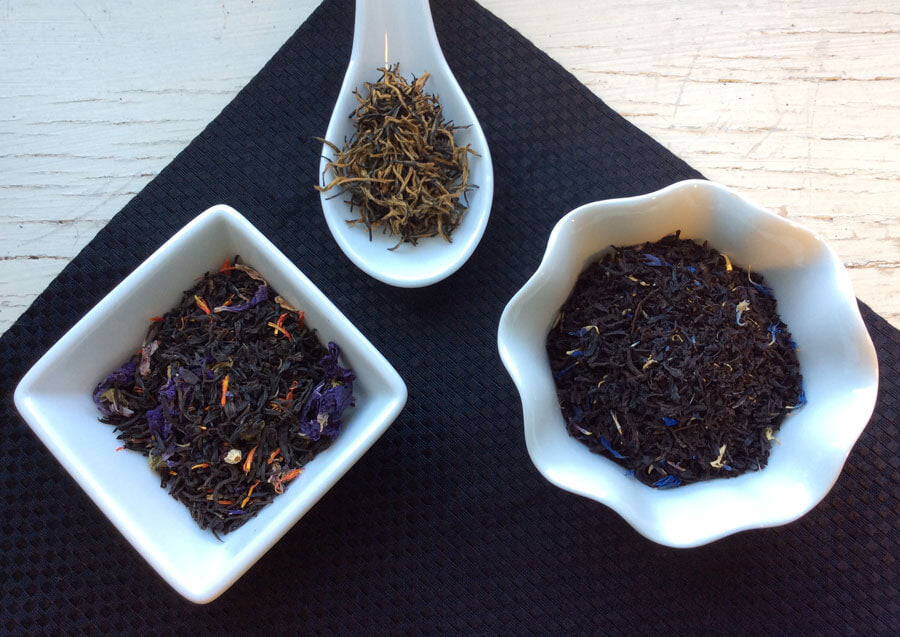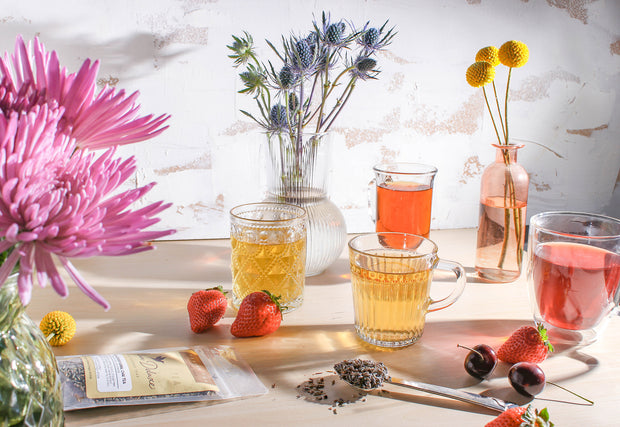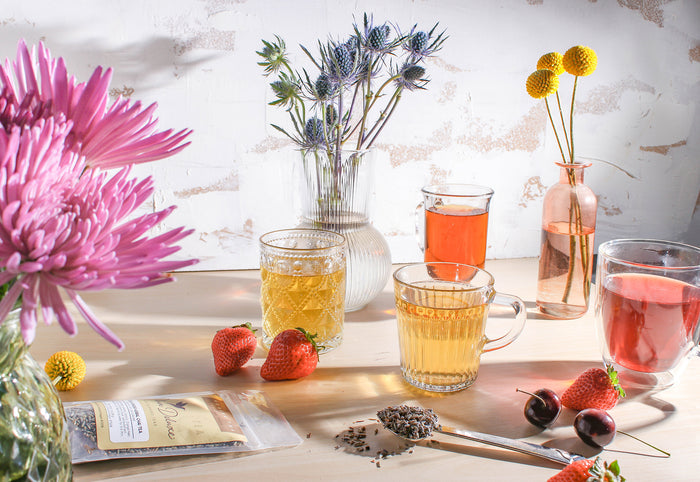
What Makes It Black?
All tea comes from the same plant, a tree-like shrub called camellia sinensis. The leaves and buds of this plant are harvested and oxidized (exposed to air) at different levels to produce the various white, green, black, and oolong teas. The longer a tea is allowed to oxidize, the darker it becomes. Black tea is oxidized the longest.
Oxidation affects not only the color but also the flavor and caffeine level of the tea. Black teas have a robust, more spicy flavor and contain the most caffeine. Once the black tea is dried, it may be blended with other teas from different regions, or it might be flavored with herbs, spices, or oils (like our Vanilla Latte Tea or Rose City Chai).

Types of Black Tea
There’s so much more to tea than meets the eye! Flavor is affected by the oxidization process, yes, but it’s also greatly influenced by the growing region and blend. Because any tea can become a black tea, it can be sourced from all over the world. One of the largest producers of black tea is Kenya, though black teas from India and China have been historically most popular amongst tea connoisseurs.
Breakfast Tea: A robust and hearty blend of black teas, generally intended to be enjoyed in the morning along with breakfast. They tend to be very high in caffeine, which is why you probably don’t want to drink them with supper. (In this respect, our Oregon Breakfast hazelnut tea with orange is a bit of a misnomer as it’s actually half-caff.) The different kinds of breakfast teas -- English, Irish, Scottish -- are all just various blends of strong teas from India and China. All of them are terrific with milk and sugar.
Assam: Bold and malty, this tea is named for the Assam region of India in which it grows. It tends to be more tannic, which makes it perfect in breakfast tea blends. Our House Blend vanilla black tea is a blend of Assam and Ceylon teas.
Ceylon: Another staple in the breakfast tea blend world, Ceylon is grown on the island of Sri Lanka off of India’s south-east coast. It tends toward a citrusy flavor and aroma, making it the most common and obvious base for Earl Grey.
Darjeeling: Nicknamed the “Champagne of Tea,” Darjeeling comes from India and has a light, fruity flavor is lovely to enjoy without any milk or sugar.
Red Tea: Wait, I thought we were talking about black tea? Yup! “Red tea” is just another name for Chinese black tea. Black teas from China are oxidized more slowly, which gives them complexity and a bit of a smokey flavor.
Keemun: This tea comes from China’s Anhui Province and is generally quite smooth, with notes of tobacco, fruit, and floral.
Lapsang Souchong: The smokey aromas and flavors of this tea actually come from just that: smoke. Produced in the Fujian Province of China, it is traditionally smoked-dried over pinewood fires.
Yunnan: If I may say so, teas from China’s Yunnan Province are some of my absolute favorites. They tend to be very complex with notes of spice and chocolate, but they leave a naturally sweet aftertaste. Even though it’s described as a “black” or “red” tea, the leaves often have a gorgeous golden color to them.

Making the Perfect Cup
Making tea is as simple as hot water poured over leaves -- except that it isn’t. The type of tea you are drinking will determine your water temperature and steeping times, both of which affect the taste of the tea. Your water itself can even change the flavor of the final beverage.
First, make sure to use filtered or spring water; treated water has too many chemicals that can make your tea taste bad. For black teas, heat the water according to a full boil (212 degrees). Once it’s boiling, pour the water over the tea leaves and allow them to steep for about 3 to 5 minutes, depending on the specific tea and your taste preferences. Milk and sugar are, again, totally up to you.
Now, if you prefer iced tea, I’ve got great news for you: Black tea cold brews the best of any of the tea types. If you’re not familiar with cold brewing, you’ll want to be; it’s the best way we’ve found to bring out all the nuance and flavor of a tea without pulling all the bitter tannins you’d normally get from oversteeping. For perfect cold-brewed black tea, we’ve got your guide right here. Really, all you have to do is throw some tea into a mason jar with cold water and maybe some of your favorite fresh fruit, pop it into the fridge overnight, and enjoy a refreshing glass in the morning. Easy peasy!
I hope you've enjoyed our little foray into the world of black tea. Next time you reach for a cuppa, see if you can taste the difference the comes from the various growing regions -- or at least simply enjoy knowing that there's more to your blend than meets the eye.

!['Chocoholic' Chocolate Tea Variety Pack [6-Pack Variety of Flavors]](http://www.plumdeluxe.com/cdn/shop/files/2.01-1800x1800-PlumDeluxe-DAJ-274695.jpg?v=1736886689&width=165)
![Patisserie Dessert Tea Variety Pack [6-Pack Variety of Flavors]](http://www.plumdeluxe.com/cdn/shop/files/4.01_-_1800_x_1800_-_Plum_Deluxe_-_DAJ_-_274695.jpg?v=1736886720&width=165)















